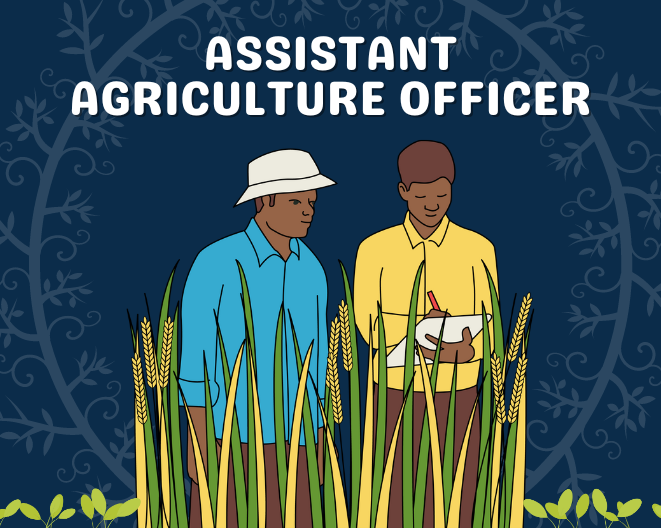In a world dealing with challenges like making sure everyone has enough food and dealing with climate change, an assistant agriculture officer (AAO) is becoming more and more important. These officers are like a crucial link between farmers and the knowledge and help they need to navigate the complex world of farming that keeps changing.
Why Assistant Agriculture Officer is so Important
Food Security Matters:
Food safety is all about making sure everyone has enough safe and nutritious food. It’s a basic right for all people and important for the world to stay stable. But things like more people, using up resources, and climate change are making it hard for us to meet this need.
Assistant Agriculture Officer Support Farmers:
An assistant agriculture officer does a big job helping farmers and making sure we have enough food. They work closely with farmers, teaching them important things like:
- Crop Production: AAOs guide farmers on the best ways to plant, grow, and harvest different crops. They consider things like how healthy the soil is, managing water, and controlling pests.
- Sustainable Farming: AAOs encourage farmers to use methods that don’t harm the environment and still keep productivity high. This includes things like changing the crops grown, conserving soil, and smartly managing pests.
- Climate-Smart Agriculture: AAOs help farmers learn about farming that’s smart about the changing climate. This means they teach techniques that help farmers deal with different weather patterns, reduce pollution, and stay strong against climate challenges.
- Technology Use: AAOs help farmers use new tools and resources. They introduce them to things like precision farming (using technology to farm more precisely), digital platforms for selling crops, and systems that give them weather info.
So, in short, AAOs are like superheroes for farmers, making sure they have the knowledge and tools to face the challenges of farming today.
Challenges and Opportunities: The Role of Training Programs
Challenges to an Assistant Agriculture Officer
Facing both challenges and opportunities, an Assistant Agriculture Officer (AAO) plays a crucial role in supporting farmers. However, they encounter obstacles that can impact their effectiveness:
- Limited Resources: AAOs often struggle with limited resources, making it difficult to reach all farmers in their district and provide the necessary support.
- Inadequate Training: Some AAOs may lack the latest knowledge and skills required to tackle complex issues like climate change and sustainable agriculture.
- Lack of Access to Technology: AAOs may face challenges in utilizing digital tools and resources effectively due to a lack of access to technology.
To overcome these challenges, an AAO can have a long-term impact through a climate change poster or a food safety workshop.
Characteristics of Effective Training Programs for AAOs:
- Local Focus: Training programs should be grounded in a deep understanding of local needs and challenges. The content should directly address the specific problems faced by farmers in the region where AAOs operate.
- Integration of Latest Advancements: Programs must incorporate the latest advancements in agricultural science and technology. This includes knowledge about climate-smart agriculture, sustainable farming practices, and the use of digital tools.
- Interactive and Engaging: Training should be interactive and engaging, utilizing a variety of learning methods. This could involve classroom lectures, field demonstrations, practical exercises, and opportunities for peer-to-peer learning.
- Communication and Interpersonal Skills: AAOs need to be equipped with strong communication and interpersonal skills. This empowers them to effectively interact with farmers, build trust, and ensure the successful adoption of new knowledge and practices.
- Continuous Learning and Professional Development: To stay relevant and adaptive, training programs should promote continuous learning and professional development for AAOs. This ensures they remain updated with the latest information and can adapt their skills to evolving needs.
In essence, effective training programs should be tailored to the unique challenges, leverage the latest advancements, and foster continuous learning. By addressing these aspects, we can empower an Assistant Agriculture Officer to contribute significantly to sustainability.
Successful Training Programs in Action
Across the globe, impactful training programs are shaping an Assistant Agriculture Officer (AAO) to meet food security challenges and adapt to climate change. Let’s dive into a few examples that highlight the real-world effectiveness and diversity of these initiatives:
International Rice Research Institute (IRRI) Training Programs:
- Who’s in Focus: AAOs and other agriculture pros in regions known for growing rice.
- What They Learn: Skills for dealing with climate challenges, managing pests, and sustainable rice growing.
- How They Learn: A mix of online learning, hands-on workshops, and in-field demonstrations.
- What Changed: Trained folks now have better know-how in handling rice production under different climate conditions. This led to more rice and improved food security in several countries.
Food and Agriculture Organization of the United Nations (FAO) Climate-Smart Agriculture (CSA) Training:
- Who’s Involved: Extension workers, including an Assistant Agriculture Officer and an Agriculture Extension Officer from different countries.
- What They Learn: Building skills to help farmers adopt climate-smart practices like efficient irrigation and sustainable crop choices.
- Learning Style: A combo of online and face-to-face training with a big focus on practical use and adapting to local needs.
- What Happened: The program raised awareness and got more farmers using climate-smart practices. This meant better preparedness for climate change and improved food security in participating countries.
National Government Initiatives:
- Case Example: The Indian government’s “Skill Development Initiative for Krishi Vigyan Kendras (KVKs)” trains AAOs and other ag extension folks on things like climate-smart agriculture and organic farming.
- Impact: The program boosted skills, making the ag extension workforce sharper. This contributed to better farming practices and increased food security in rural areas.
Partnerships and Collaboration:
- Public-Private Teamwork: Different groups team up with private companies to create and deliver Assistant Agriculture Officer training programs. This means bringing in expertise from both sides and making sure AAOs get access to the newest tech and resources.
- Farmer-to-Farmer Sharing: Programs that connect seasoned farmers with AAOs are goldmines for practical knowledge and best practices suited to local conditions.
These examples paint a picture of the varied approaches and positive outcomes of successful training programs for AAOs. By adapting these models and encouraging collaboration among different players, we can give AAOs the tools they need to be key players in building a more secure and sustainable food system for the future.
Conclusion
Investing in training programs for an Assistant Agriculture Officer is a critical step toward a secure and sustainable food system. By equipping AAOs with the necessary knowledge, skills, and resources, we can empower them to become effective agents of change in the agricultural sector, contributing to food security and climate resilience in the face of ever-growing challenges.









Leave feedback about this
You must be logged in to post a comment.